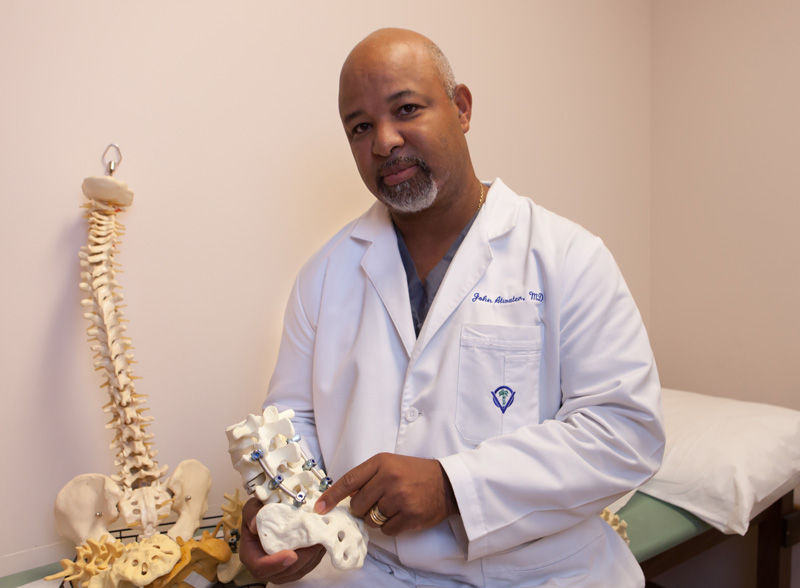If you have back pain, you are far from alone.
The National Institute of Neurological Disorders at the National Institutes of Health says about 80 percent of adults will experience this all-too-frequent phenomenon at some point during their lives, and that the problem tends to worsen with age.
Determining the causes and – perhaps even more importantly – the best treatments for back pain in all its many forms, however, can be something of a medical Gordian knot.
Vero Beach’s Dr. John Atwater has worked his entire 20-year career diagnosing, treating and surgically repairing back problems. He says he is keenly aware of just how frustrating and painful back and neck pain can be for his patients. In fact, Atwater says, “Even though I’m a spine guy, I’m really a pain guy.” Or, more correctly, a pain-relieving guy.
That’s good news for those with back problems since the NIH also reports that between 1990 and 2010, back pain leapfrogged seven other diseases to rank as, “the third most burdensome condition in the U.S.,” behind only ischemic heart disease and obstructive pulmonary (lung) disease.
“Most people,” says Atwater, “don’t realize how bad that pain is,” until they experience it themselves.
It’s probably not surprising that so many people are afflicted with back problems considering the mechanics of our spinal structure. From the neck to the pelvis, 33 vertebrae, more than 20 vertebral disks and a host of muscles and nerve bundles must all work together in spite the twists, turns and constant demands we place on our spines.
With so many individual parts, just determining the actual source of pain can be difficult. After all, lower back pain, middle back pain, upper back pain or low back pain with sciatica as well as nerve and muscular problems, degenerative disc disease and arthritis can all play a role.
There is “acute” or short term back pain, “subacute” back pain and “chronic” back pain. NIH defines acute back pain as lasting, “a few days to a few weeks,” while subacute pain “lasts between four and 12 weeks,” and chronic pain, “persists for 12 weeks or longer.” That’s an easy enough set of definitions to understand unless it’s your back that’s been hurting for 10 or more weeks.
Men and women are affected equally by back pain. The symptoms can range in intensity from a constant dull ache to a sharp and sudden piercing sensation that can completely immobilize its victim.
Even the terminology of back pain can be a problem. When doctors talk about pinched nerves, degenerated discs, slipped discs, herniated discs, bulging discs, scoliosis, spondylolisthesis, spinal stenosis, endometriosis, osteoarthritis, fibromyalgia and a host of other conditions without fully explaining them, it can leave patients feeling bewildered as well as in pain.
Atwater says the bulk of the back issues he treats here in Vero are age-related.
“You don’t see much spine trauma here,” explains this University of Virginia medical school grad who served his internship at Baltimore’s prestigious Johns Hopkins, his orthopedic residency at Howard University and his spine fellowship at the University of Louisville, “but I do see more degenerative spinal conditions.”
Among the most common degenerative conditions Atwater sees are spinal stenosis and osteoarthritis. In the most rudimentary of terms, spinal stenosis is a narrowing of the spine or the areas of the spine where nerve bundles branch out to the rest of the body. That puts pressure on those nerves and can cause severe pain. Osteoarthritis, meanwhile, is essentially the age-related breakdown of the cartilage in the joints and discs in the neck and lower back and can be equally debilitating.
“We try,” Atwater continues, “to treat everybody non-operatively to start out with,” using medication and physical therapy.
The Mayo Clinic agrees with Atwater’s approach. “Back surgery,” it says on its website, “can help relieve some causes of back pain,” but adds that, “most back pain resolves on its own within two months.” In fact, according to Atwater, “only about one percent” of acute back pain sufferers will actually require surgery.
When surgery is required, however, Atwater has a somewhat different spin on the modern surgical buzz phrase, “minimally invasive.” For him, “minimally disruptive” is a more accurate term. “It’s what happens underneath the skin that matters,” Atwater explains, saying his aim is to avoid “disrupting the muscle envelope” that supports the spine.
He says this approach allows his surgical patients to recover much faster than they might if different techniques were used. He also says replacements for worn-out disks newly approved by the FDA are, “the wave of the future” in cases where disk degeneration is the cause of a patient’s pain.
As to prevention of spine problems, Atwater says Vero area residents have a simple way they can help protect themselves. “Swimming,” he says, is an ideal exercise. With the added buoyancy of the water, swimming helps strengthen all the muscles that support the entire spinal system.
Sharing his expertise, says Atwater, is important to him. He just returned from a 19,000 mile roundtrip to Cambodia where he spoke at a spinal symposium sponsored by medical device manufacturer, Aegis. During his brief 48-hour stay, Atwater found time to “help out” in spinal surgeries in Cambodia.
Dr. John Atwater is with Vero Orthopedics & Vero Neurology at 1155 35th Lane, Suite 100 in Vero Beach and 801 Wellness Way, Suite 100 in Sebastian. The number in Vero is 772-257-3600. The Sebastian number is 772-388-1659.

